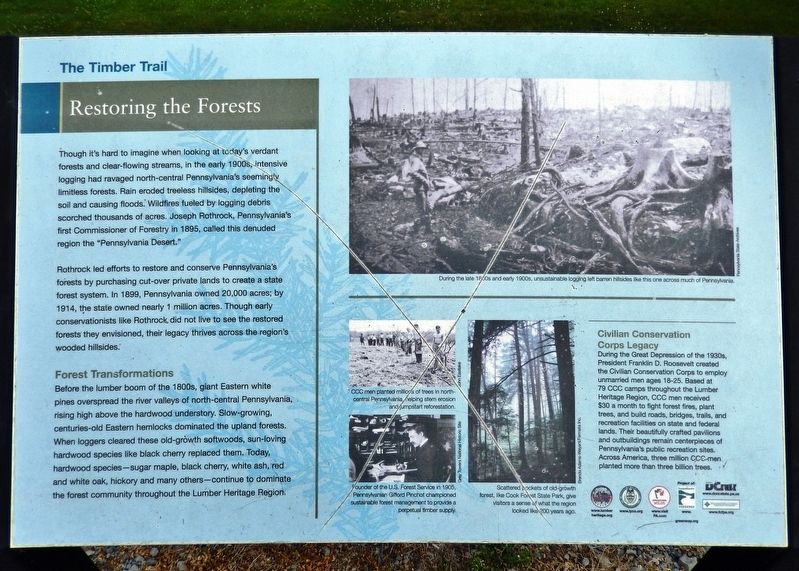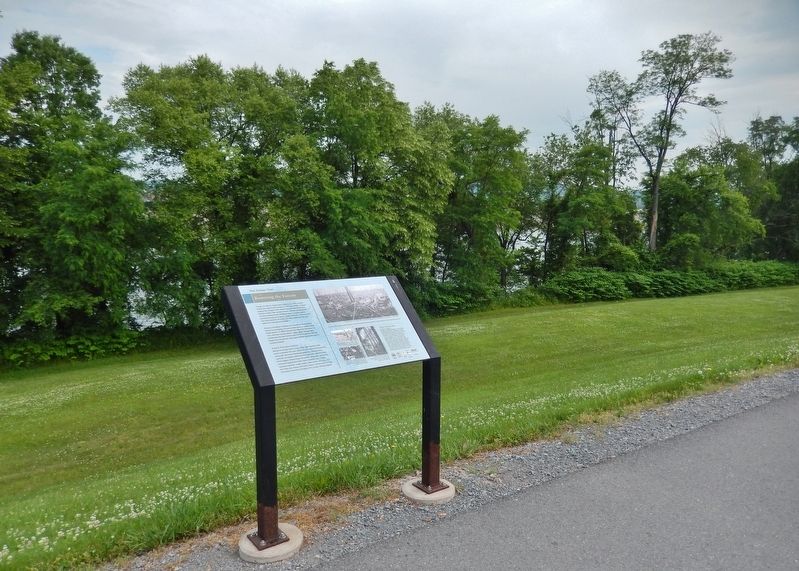South Williamsport in Lycoming County, Pennsylvania — The American Northeast (Mid-Atlantic)
Restoring the Forests
The Timber Trail
— Susquehanna Riverwalk —
Though it's hard to imagine when looking at today's verdant forests and clear-flowing streams, in the early 1900s, intensive logging had ravaged north-central Pennsylvania's seemingly limitless forests. Rain eroded treeless hillsides, depleting the soil and causing floods. Wildfires fueled by logging debris scorched thousands of acres. Joseph Rothrock, Pennsylvania's first Commissioner of Forestry in 1895, called this denuded region the "Pennsylvania Desert."
Rothrock led efforts to restore and conserve Pennsylvania's forests by purchasing cut-over private lands to create a state forest system. In 1899, Pennsylvania owned 20,000 acres; by 1914, the state owned nearly 1 million acres. Though early conservationists like Rothrock, did not live to see the restored forests they envisioned, their legacy thrives across the region's wooded hillsides.
Forest Transformations
Before the lumber boom of the 1800s, giant Eastern white pines overspread the river valleys of north-central Pennsylvania, rising high above the hardwood understory. Slow-growing, centuries-old Eastern hemlocks dominated the upland forests. When loggers cleared these old-growth softwoods, sun-loving hardwood species like black cherry replaced them. Today, hardwood species — sugar maple, black cherry, white ash, red and white oak, hickory and many others — continue to dominate the forest community throughout the Lumber Heritage Region.
Civilian Conservation Corps Legacy
During the Great Depression of the 1930s, President Franklin D. Roosevelt created the Civilian Conservation Corps to employ unmarried men ages 18-25. Based at 79 CCC camps throughout the Lumber Heritage Region, CCC men received $30 a month to fight forest fires, plant trees, and build roads, bridges, trails, and recreation facilities on state and federal lands. Their beautifully crafted pavilions and outbuildings remain centerpieces of Pennsylvania's public recreation sites. Across America, three million CCC men planted more than three billion trees.
[photo captions]
• During the late 1800s and early 1900s, unsustainable logging left barren hillsides like this one across much of Pennsylvania.
• CCC men planted millions of trees in north-central Pennsylvania, helping stem erosion and jumpstart reforestation.
• Founder of the U.S. Forest Service in 1905, Pennsylvanian Gifford Pinchot championed sustainable forest management to provide a perpetual timber supply.
• Scattered pockets of old-growth forest, like Cook Forest State Park, give visitors a sense of what the region looked like 200 years ago.
Erected by Lumber Heritage Region of Pennsylvania, Inc., and Pennsylvania
Department of Conservation & Natural Resources.
Topics and series. This historical marker is listed in these topic lists: Charity & Public Work • Environment • Horticulture & Forestry • Parks & Recreational Areas. In addition, it is included in the Civilian Conservation Corps (CCC) series list.
Location. 41° 14.004′ N, 77° 0.106′ W. Marker is in South Williamsport, Pennsylvania, in Lycoming County. Marker can be reached from Market Street (U.S. 15) ¼ mile south of Susquehanna Beltway (U.S. 220), on the right when traveling south. Marker is located along the Susquehanna Riverwalk, on the south side of the West Branch Susquehanna River, between Market Street and Maynard Street. Touch for map. Marker is in this post office area: Williamsport PA 17701, United States of America. Touch for directions.
Other nearby markers. At least 8 other markers are within walking distance of this marker. Floods on the Susquehanna (about 500 feet away, measured in a direct line); Growing a Sustainable Forest Industry (about 500 feet away); The Saw Dust War (approx. 0.2 miles away); Traveling Through a Rugged Region (approx. 0.2 miles away); Williamsport's Lumber Barons (approx. 0.2 miles away); Spars and Sticks: Rafting the West Branch (approx. ¼ mile away); Opening the Frontier: West Branch Canal (approx. ¼ mile away); The Mills that Made Williamsport (approx. 0.3 miles away). Touch for a list and map of all markers in South Williamsport.
Related markers. Click here for a list of markers that are related to this marker. The Timber Trail
Also see . . .
1. Joseph Trimble Rothrock and the Preservation of Penn’s Woods.
The lush, verdant woodlands characteristic of Pennsylvania’s landscape are almost entirely second-growth forests, in existence roughly for less than a century. Had it not been for the groundbreaking work of many conservationists in the late nineteenth and early twentieth centuries, the Keystone State’s present terrain would be dramatically different. One of the most important of those visionaries was Joseph Trimble Rothrock (1839–1922), who made enduring contributions to both forestry and botany and has been crowned the “Father of Forestry in Pennsylvania.” Public awareness of his contributions, however, has been eclipsed by that of such figures as Gifford Pinchot and Theodore Roosevelt. Nevertheless, it was Rothrock who organized the state public forestry agency in Pennsylvania and subsequently led the forestry movement.(Submitted on February 13, 2022, by Cosmos Mariner of Cape Canaveral, Florida.)
2. CCC in Pennsylvania.
From 1933 to 1942, hundreds of thousands of unemployed men worked in camps throughout Pennsylvania. Some camps were on army bases, some were in national parks, some worked with the soil conservation service, but most camps were in state parks and forests. Pennsylvania had the second highest number of camps to California. Pennsylvania received so many camps because it already had a plan in place for the camps, thanks to the forward thinking of Governor Gifford Pinchot.(Submitted on February 13, 2022, by Cosmos Mariner of Cape Canaveral, Florida.)
Credits. This page was last revised on September 8, 2022. It was originally submitted on February 13, 2022, by Cosmos Mariner of Cape Canaveral, Florida. This page has been viewed 91 times since then and 10 times this year. Photos: 1, 2. submitted on February 13, 2022, by Cosmos Mariner of Cape Canaveral, Florida.

